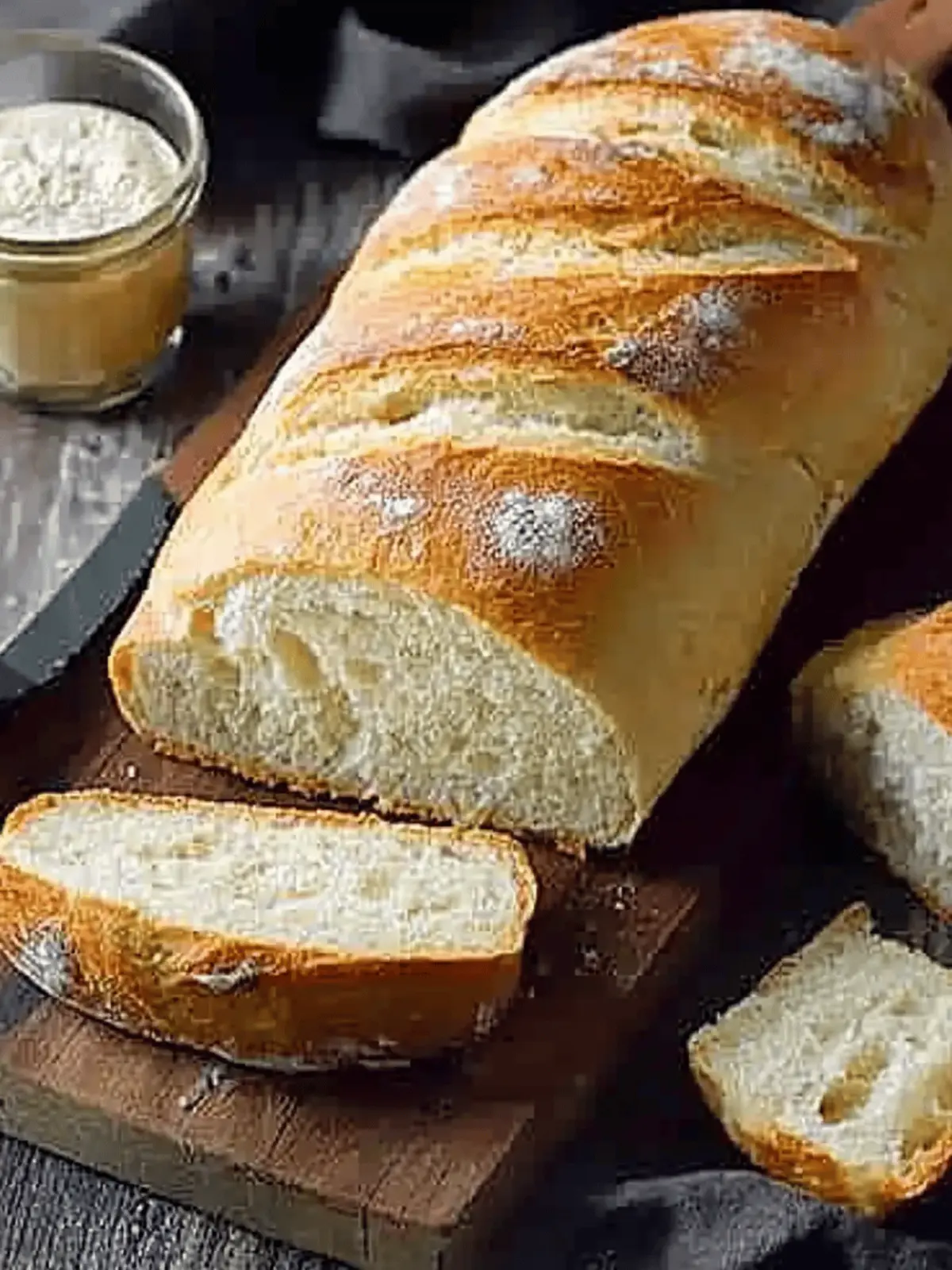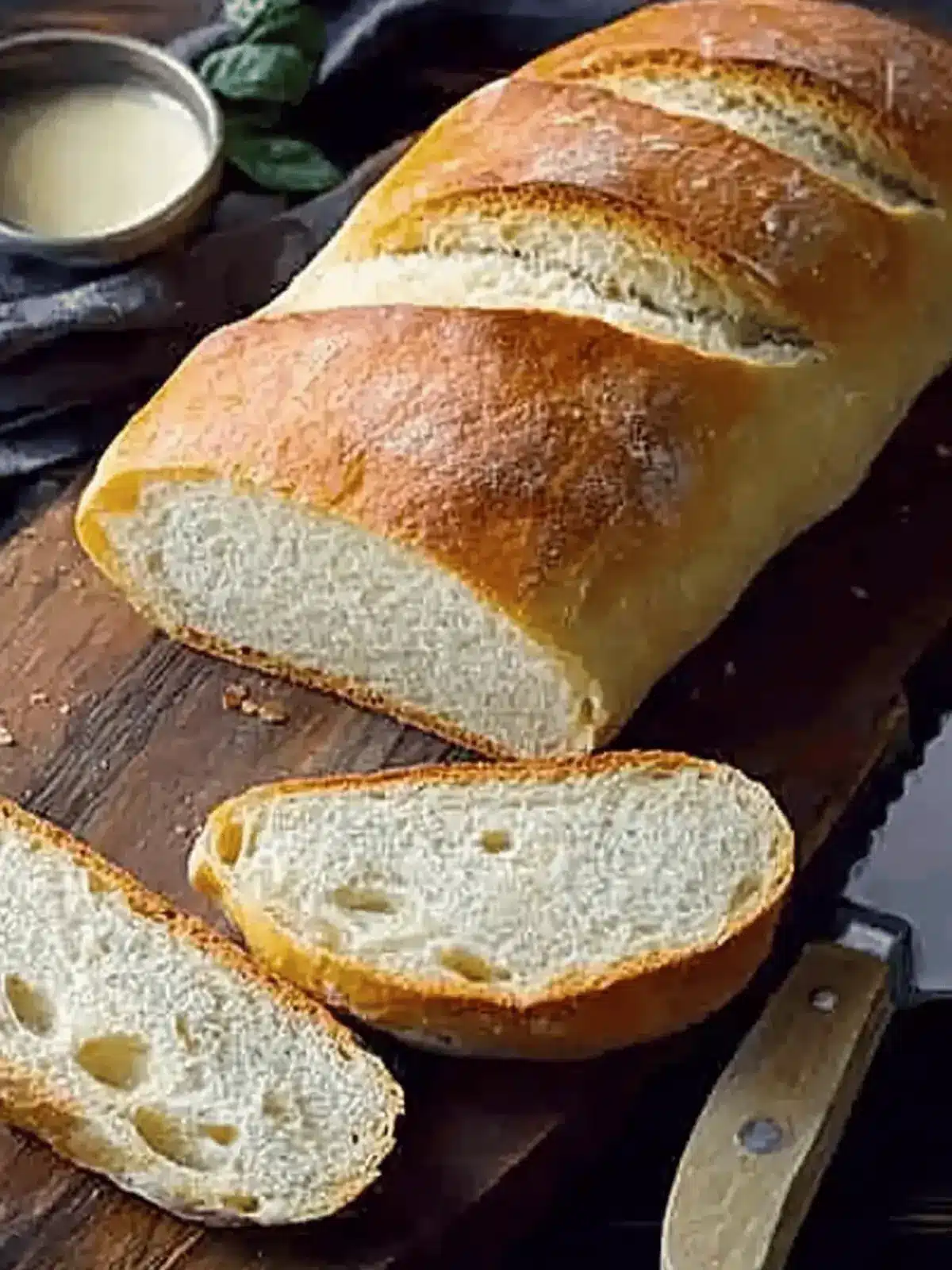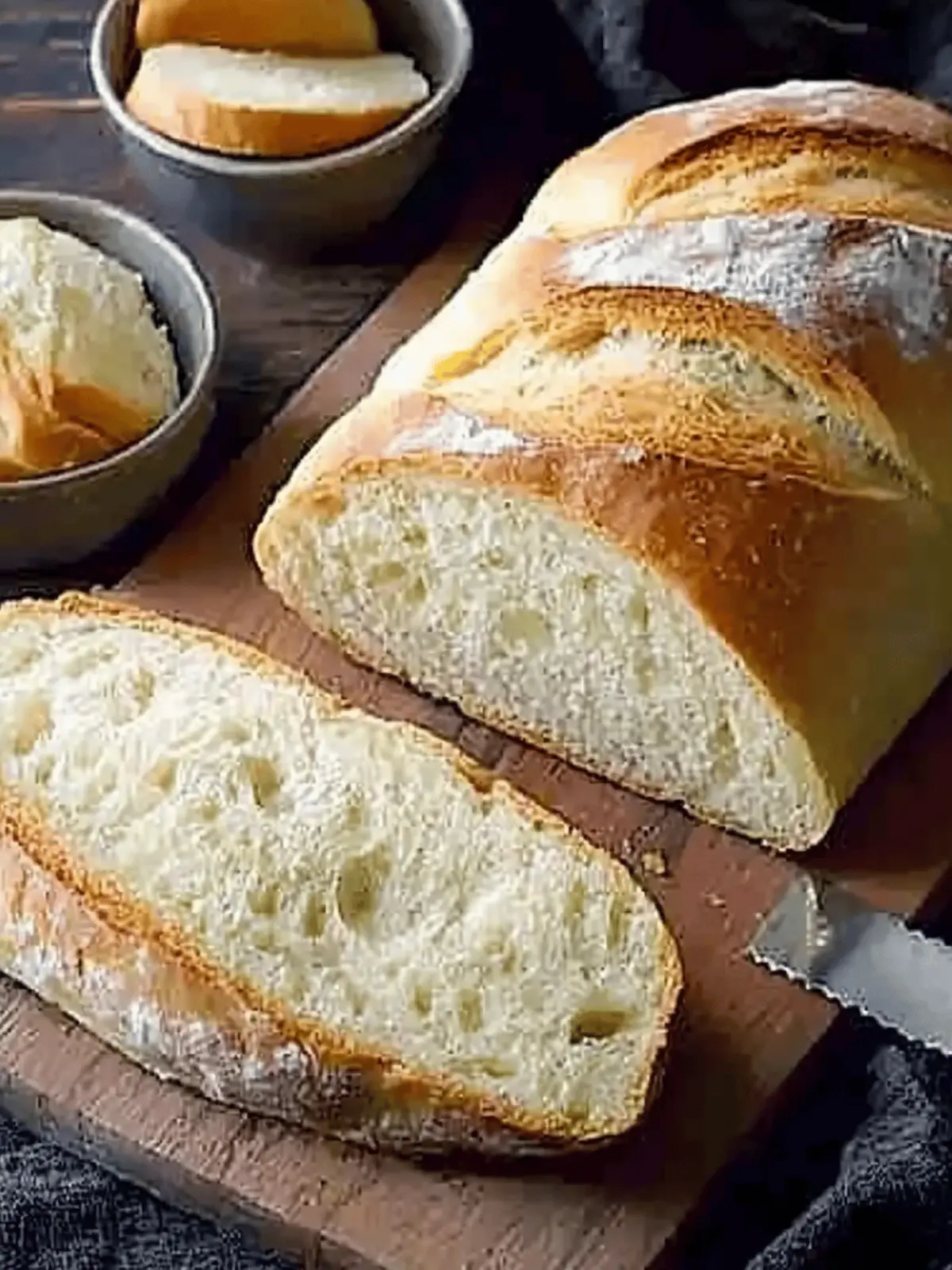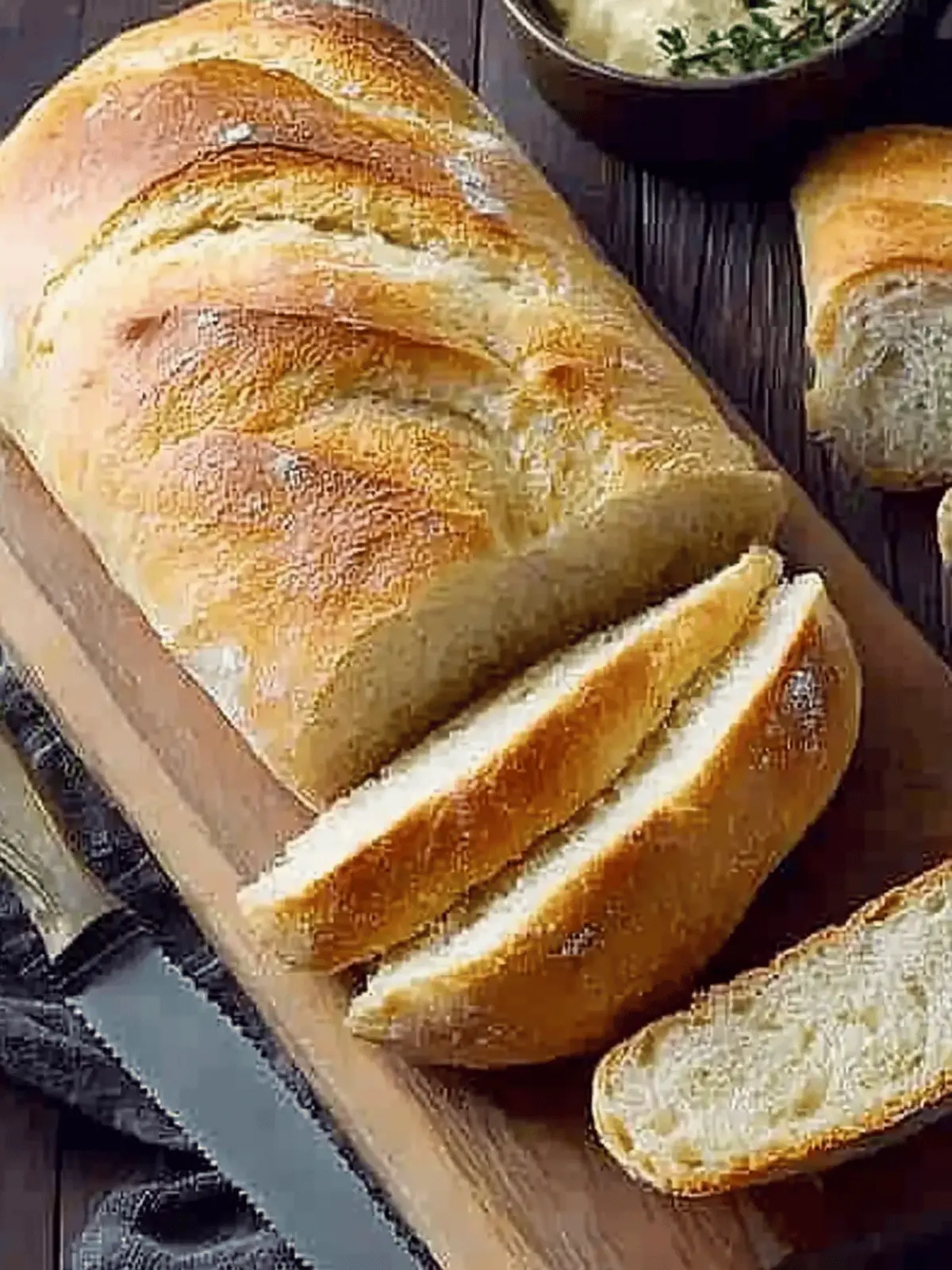There’s something undeniably enchanting about walking into a kitchen filled with the warm, buttery aroma of freshly baked Italian bread. If you’ve ever longed to recreate that cozy feeling at home, you’re in for a treat! This easy homemade Italian bread combines pantry staples into a delightful loaf that’s not just a sidekick to your pasta but a star on its own.
Picture this: The soft, airy interior beckons for a dip in rich olive oil, while the crust adds a satisfying crunch with each bite. It’s a simple recipe that’s suitable for both baking novices and seasoned chefs looking to impress. Need a quick solution to liven up your mealtime? This Italian bread checks all the boxes: effortless preparation, a comforting texture, and endless possibilities for customization. So roll up your sleeves, and let’s bring the heartwarming taste of Italy to your kitchen!
Why Choose Italian Bread for Your Meals?
Irresistible aroma: The scent of baking Italian bread fills your home, creating a warm, inviting atmosphere perfect for gatherings.
Easy to make: This straightforward recipe uses basic ingredients, ensuring anyone can whip it up in no time.
Soft texture: With its tender, airy crumb and crisp crust, this bread is a textural delight that elevates any meal.
Versatile companion: Whether it’s served warm with olive oil or as the centerpiece of a meal, this bread complements countless dishes.
Customizable goodness: Feel free to add herbs or substitute flours for unique flavors—making this recipe as flexible as your taste!
Italian Bread Ingredients
For the Dough
• Active Dry Yeast – The fermentation agent that helps the bread rise; always check the freshness for the best results.
• Warm Water (110° to 115°F) – Essential for activating the yeast; ensure it’s not too hot to keep the yeast alive.
• Sugar – This feeds the yeast for a better rise and enhances browning for a beautiful crust.
• Salt – Vital for flavor and dough strength; it should be added only after the yeast has activated for optimal results.
• All-Purpose Flour – The main structure of the bread; substituting with bread flour can provide a chewier bite if preferred.
For Serving
• Olive Oil – A delightful accompaniment for dipping that enhances the homemade experience; perfect for complementing the soft texture of Italian bread.
• Balsamic Vinegar – A tangy alternative for dipping that pairs wonderfully and adds depth to the flavor profile.
How to Make Italian Bread
- Dissolve Yeast: In a large bowl, combine the warm water (110° to 115°F) with the active dry yeast. Let it sit for about 5 minutes until it becomes foamy, ensuring your yeast is alive.
- Add Ingredients: Stir in sugar, salt, and 3 cups of all-purpose flour. Mix on medium speed for 3 minutes until combined for a smooth batter.
- Form Dough: Gradually add the remaining flour, a little at a time, until a soft dough forms that pulls away from the sides of the bowl.
- Knead Dough: Turn the dough onto a lightly floured surface and knead for 6-8 minutes until it is smooth and elastic. You want a nice stretchy texture!
- First Rise: Place the kneaded dough in a greased bowl, cover it with a damp cloth, and let it rise in a warm place until it doubles in size, about 1 hour.
- Shape Loaves: Once risen, punch down the dough gently, then divide it into two equal pieces. Shape each piece into a loaf and place seam-side down on greased baking sheets. Let them rise for another 30 minutes.
- Preheat Oven: While the dough rises, preheat the oven to 450°F. Score the top of each loaf with a sharp knife and sprinkle lightly with flour.
- Bake Perfectly: Bake for 15-20 minutes until golden brown. The bread should sound hollow when tapped on the bottom—this is the perfect sign it’s done!
- Cool Down: Let the loaves cool on wire racks until room temperature before slicing.
Optional: Serve with warm olive oil and balsamic vinegar for a delightful dipping experience.
Exact quantities are listed in the recipe card below.
What to Serve with Italian Bread?
Imagine the comforting aroma of freshly baked bread wafting through your home, ready to complement your next meal.
- Creamy Tomato Soup: The velvety texture of this soup pairs beautifully with Italian bread for a soul-warming experience that’s perfect for dipping.
- Garlic Butter Shrimp: Succulent shrimp in flavorful garlic butter creates a delightful seafood dish that balances the bread’s softness with its rich taste.
- Balsamic Roasted Vegetables: These sweet, caramelized veggies add a touch of earthiness that harmonizes perfectly with the light, airy texture of Italian bread.
- Homemade Pesto: A vibrant blend of basil, nuts, and olive oil makes for an irresistible dipping sauce, elevating your bread to a whole new level of flavor.
- Classic Italian Salad: Crisp greens and juicy tomatoes with a drizzle of balsamic vinaigrette make a refreshing complement that enhances the overall meal experience.
- Margarita Pizza: A slice of this cheesy delight alongside your bread provides a taste of Italy right at your table, making every bite feel like a celebration.
- Spicy Arrabbiata Pasta: Serve your Italian bread with this zesty pasta for an aromatic feast; it’s a winning combination of spice and comforting carbs.
- Olive Tapenade: This robust olive spread adds a Mediterranean flair that contrasts beautifully with the soft bread, making every bite a burst of flavor.
Expert Tips for Italian Bread
- Yeast Activation: Always test the yeast before use; it should froth in warm water and sugar. If it doesn’t, your Italian bread won’t rise properly.
- Temperature Control: Maintain the water temperature between 110°F to 115°F; exceeding this can kill the yeast and hinder fermentation.
- Kneading Technique: Knead until the dough is elastic and smooth. Under-kneading can lead to dense bread, while over-kneading can make it tough.
- Perfect Rising Environment: Create a warm and humid environment for the dough to rise. A cold room can delay the process significantly.
- Scoring for Texture: Scoring the tops of the loaves allows steam to escape during baking, helping achieve that deliciously crispy crust for your Italian bread.
Make Ahead Options
These easy homemade Italian bread loaves are perfect for meal prep enthusiasts! You can fully knead and shape the dough up to 24 hours in advance before the final rise. Simply cover the shaped loaves with plastic wrap or a damp cloth and refrigerate them overnight to maintain their quality. When you’re ready to bake, let them come to room temperature for about 30 minutes while preheating your oven to 450°F, then score and bake as instructed. This way, you’ll enjoy freshly baked Italian bread with minimal effort on busy weeknights, and it will be just as delicious as if you made it all at once!
How to Store and Freeze Italian Bread
Room Temperature: Store your Italian bread in a bread box or wrapped in a kitchen towel for up to 3 days to maintain its soft texture.
Fridge: Avoid refrigeration as it can dry out the bread; instead, if necessary, use plastic wrap or a resealable bag for short-term storage.
Freezer: For longer preservation, slice the bread and wrap each piece tightly in foil before placing it in a freezer bag. It will keep well for up to 3 months.
Reheating: To enjoy your frozen Italian bread, simply thaw overnight in the fridge, then reheat in the oven at 350°F for about 10 minutes to restore its freshness.
Italian Bread Variations
Feel free to explore these delightful twists on your basic Italian bread recipe for a truly unique experience!
-
Herbed Bread: Add 1-2 tablespoons of dried herbs like rosemary or oregano directly into the dough for a fragrant infusion.
-
Whole Wheat Twist: Replace half of the all-purpose flour with whole wheat flour for a nuttier flavor and added nutrition.
-
Garlic Infusion: Mix minced garlic into the dough for an aromatic touch that complements its soft texture beautifully.
-
Olive Oil Enrichment: Incorporate 2-3 tablespoons of extra virgin olive oil in the mixing stage for a richer, more tender loaf.
-
Cheesy Delight: Fold in shredded cheese, such as parmesan or mozzarella, into the dough to create pockets of melty goodness.
-
Spicy Kick: Blend in crushed red pepper flakes into your dough for a warm, spicy contrast to the soft, airy texture.
-
Sun-Dried Tomatoes: Add chopped sun-dried tomatoes to the dough for a burst of flavor that transports you straight to Italy with each bite.
-
Cinnamon Sugar Breakfast Bread: For a sweet variation, add 1-2 teaspoons of cinnamon and ¼ cup of sugar to the dough, perfect for a delightful breakfast treat.
Italian Bread Recipe FAQs
How do I know if my yeast is fresh?
Absolutely! To test if your active dry yeast is fresh, dissolve it in warm water (between 110° and 115°F) with a pinch of sugar. If the mixture becomes frothy after about 5 to 10 minutes, your yeast is good to go! If not, it’s best to grab a new pack for your Italian bread.
How should I store leftover Italian bread?
For optimal freshness, store your Italian bread at room temperature in a bread box or wrapped in a clean kitchen towel. This keeps the crust from becoming too soft or too hard. You can enjoy it for up to 3 days. If you need to extend its shelf life, consider freezing!
Can I freeze Italian bread? How?
Very much so! To freeze your Italian bread, slice it into individual servings if desired, then wrap each piece tightly in foil and place them in a freezer-safe bag. This keeps them fresh for up to 3 months. When you’re ready to enjoy, thaw overnight in the fridge and reheat in the oven at 350°F for about 10 minutes to bring back that just-baked texture.
What should I do if my dough doesn’t rise?
If your dough isn’t rising, the most common culprits are temperature or inactive yeast. Ensure your warm water is within the perfect range (110° to 115°F) and that your yeast is fresh. If the room is too cool, try placing the dough in a slightly warmer area, like near a preheating oven, or covering it with a damp cloth to create a cozy environment.
Can I substitute any ingredients for dietary reasons?
The more the merrier in terms of customization! You can substitute all-purpose flour with whole wheat flour for a nuttier flavor, or even incorporate gluten-free flour mixes for those with gluten sensitivities. Just keep in mind that the texture may vary, so follow guidelines for specific flour types for best results.
Is this Italian bread safe for my pets?
While your furry friends might be curious about your delicious Italian bread, it’s best to avoid sharing any. Bread isn’t harmful to pets in small amounts, but the yeast can be problematic, leading to digestive issues for them. Always prioritize their safety and stick to pet-friendly treats!

Irresistibly Soft Italian Bread Perfect for Dipping
Ingredients
Equipment
Method
- In a large bowl, combine the warm water with the active dry yeast. Let it sit for about 5 minutes until foamy.
- Stir in sugar, salt, and 3 cups of all-purpose flour. Mix on medium speed for 3 minutes until combined.
- Gradually add the remaining flour until a soft dough forms that pulls away from the sides.
- Turn the dough onto a floured surface and knead for 6-8 minutes until smooth and elastic.
- Place the kneaded dough in a greased bowl, cover with a damp cloth, and let it rise until doubled, about 1 hour.
- Once risen, punch down the dough, divide it into two pieces, shape into loaves, and place on greased sheets.
- Preheat the oven to 450°F. Score the top of each loaf and sprinkle lightly with flour.
- Bake for 15-20 minutes until golden brown and sounds hollow when tapped.
- Let the loaves cool on wire racks before slicing.








